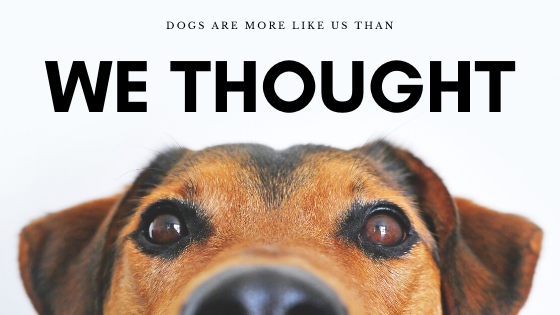Dogs Are More Like Us Than We Thought
Dogs Have More Human like Traits than their Ancestor the Wolf
More
than
11,000
years
ago
some
wolves
started
leaving
their
pack
to
scavenge
for
food
by
following
humans.
As
a
result,
research
suggests,
our
canine
friends
started
developing
human
like
traits.
Dogs
are
highly
social
and
can
read
signs
from
other
dogs
as
well
as
humans.
They
are
highly
sensitive
to
humans
and
can
even
recognize
the
tone
of
our
voices,
facial
expressions,
and
even
posture.
By
socializing
with
humans
for
thousands
of
years,
dogs
have
sharpened
their
own
social
skills
to
the
extent
that
they
mirror
human
traits.
Here
are
some
of
those
traits:
Eavesdropping
Dogs
can
understand
commands
and
even
follow
instructions,
but
can
they
understand
interactions
between
humans?
A
new
study
seems
to
suggest
that
they
often
eavesdrop
on
you
when
you
interact
with
other
people.
In
one
study,
dogs
seemed
to
be
more
receptive
to
humans
who
were
kind
to
other
humans.
The
measure
was
whether
the
subjects
would
receive
a
positive
reaction
from
the
dog
owner.
The
researchers
found
that
the
pet
was
able
to
read
the
owners
reactions
towards
other
people.
Not
everyone
was
convinced
by
this
study.
Some
felt
that
the
dog
simply
responded
to
those
people
they
thought
were
likely
to
be
kind
to
them.
For
example,
if
a
dog
were
to
see
a
man
giving
food
to
a
beggar,
they
may
respond
positively
to
him
because
he
is
likely
to
be
the
one
to
give
them
food.
Another
study
involved
dogs
watching
their
owners
attempt
to
retrieve
a
tape
from
a
container.
The
study
had
three
groups;
in
the
helper
group,
the
subjects
requested
help
from
another
person
who
agreed
to
assist
with
the
task.
In
the
non-helper
group,
the
person
requested
for
help
turned
their
backs.
The
third
subject
was
neutral
and
simply
sat
in
the
room
as
a
control.
In
subsequent
tests
the
dog
seemed
to
favor
the
neutral
subject
over
the
non-helper.
But
there
was
no
difference
between
the
helper
and
the
neutral
group.
This
suggests
that
more
studies
could
confirm
what
the
intention
is
when
they
eavesdrop
on
humans.
Feeling Jealous
Another
study
also
suggests
that
our
canine
buddies
may
also
feel
envious.
For
long,
it
has
been
assumed
that
envy
is
a
human
construct.
However,
a
new
study
suggests
it
may
not
be
unique
to
humans.
The
study
adopted
the
same
methods
used
on
infants.
36
dog
owners
were
asked
to
show
affection
towards
a
plush
robot
dog
in
the
presence
of
their
pet.
About
80%
of
the
dogs
touched
their
owners
more
times
then
they
ignored
their
pets
and
played
with
the
robot
instead.
The
researchers
not
only
found
that
dogs
can
feel
complex
emotions
such
as
jealousy,
it
also
made
them
conclude
that
a
primordial
form
of
the
emotion
exists
in
many
animals.
It
also
explains
why
infants
as
young
as
6
months
old
show
such
emotional
reactions
when
maternal
attention
is
directed
elsewhere.
Response to Human Gaze
Wolves,
birds,
tortoises,
dolphins,
apes
and
domesticated
goats
can
respond
to
the
human
gaze.
When
it
comes
to
dogs,
for
a
long
time
it
was
understood
that
dogs
could
not
follow
the
gaze
into
a
blank
space.
It
was
widely
believed
that
they
only
follow
the
gaze
whenever
toys
and
food
were
present.
However,
a
new
study
suggests
that
it
is
training
that
determines
whether
dogs
will
follow
their
owner’s
gaze
even
when
it
is
directed
to
a
blank
space.
In
a
test
to
determine
how
following
the
gaze
can
be
influenced
by
training,
Lisa
Wallis
from
Vetmeduni
in
Vienna
investigated
145
Border
Collies
whose
age
ranged
from
6
months
to
14
years.
The
Border
Collies
were
observed
over
a
considerable
period
of
their
lifespan.
They
were
split
into
two
groups;
a
test
and
a
control.
Dogs
in
both
groups
had
received
varying
levels
of
training.
A
command
“watch”
was
given
to
indicate
that
they
should
follow
the
gaze.
When
the
experimenter
used
the
command
and
looked
at
the
door
of
the
room
the
untrained
dogs
followed
the
gaze.
The
trained
ones
continued
to
look
at
the
experimenters
face.
This
is
because
trained
dogs
have
learned
to
look
at
the
facial
expressions
first
before
following
the
gaze.
The
untrained
collies
stopped
looking
at
the
door
when
they
were
trained
and
instead
started
looking
at
the
experimenter’s
face.
Another
interesting
observation
was
that
the
untrained
group
looked
back
and
forth
between
the
door
and
the
investigator.
The
phenomenon
is
referred
to
as
“check
backs”
or
“double
looking”
and
has
only
been
previously
observed
in
humans
and
chimps.
Scientists
are
still
researching
these
aspects
of
the
dog
behavior.
Findings
from
these
studies
can
help
us
understand
how
man
and
dog
evolved
side-by-side.
It
can
give
us
further
insights
into
the
psychological
nature
of
our
furry
friends
so
that
we
can
improve
our
relationship
and
be
healthier
while
working
together.

